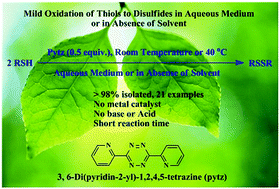Thiols are efficiently oxidized to disulfides (RSSR) in the presence of 3,6-di(pyridin-2-yl)-1,2,4,5-tetrazine (pytz) in aqueous medium, as well as in the absence of a solvent under mild and metal-free conditions. A broad range of alkyl, aryl and heterocyclic symmetrical disulfides can be easily obtained in almost quantitative yields. The X-ray single crystal structure of 2-aminocyclopent-1-ene-1-carbothioic dithioperoxyanhydride (disulfide obtained from 2-aminocyclopentene-1-dithiocarboxylic acid, ACDA) is reported. The reaction mechanism has been studied thoroughly. It is shown that the reaction proceeds through the formation of an organosulphur radical. Pytz interacts with thiol to accept one electron and produces an organosulphur radical. Pytz ultimately accepts two electrons to form H2pytz and is capable of oxidizing 2 equivalents of thiols.
